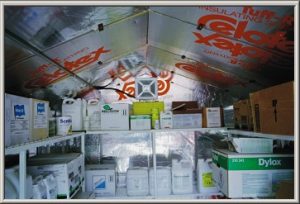Most pesticide labels call for storage in a “cool, dry” place. For your safety, always provide adequate ventilation and light.
 Temperature
Temperature
Consult the pesticide label to determine the acceptable limits at which the storage temperature should not exceed or fall. As a general rule of thumb, the temperature inside the storage area should not get below 40 F or over 100 F. Some pesticides will freeze when they get too cold and the container may crack and leak. Freezing temperatures may cause some formulations to separate. Some pesticides expand when they get very hot. High temperatures also cause plastic to melt or become brittle and may cause a buildup of pressure that may break glass containers or cause the chemicals to volatilize or spill out when the container is opened. Excessive heat may cause explosion or fire. Exhaust fans will reduce temperatures. Minimize fire hazards if you provide supplemental heating to the storage area.
Humidity
Keep the storage area dry. High humidity causes some dry formulations to cake, clump, breakdown, or dissolve, and release pesticide, making them unusable and dangerous. Humidity also weakens paper and cardboard containers, and will eventually rust metal containers. It may cause labels to peel off or become unreadable.
Ventilation
(not applicable to homeowner pesticides)
The storage building needs constant ventilation to prevent the buildup of toxic fumes and to reduce humidity. Install louvered air intake vents low on the wall with the entrance door, or in the lower part of the door, and an exhaust fan or louvered air vents high on the opposite wall. This allows vapors to flow away from anyone entering or inside the storage unit and provides a continuous flow of air when the door is open. An exhaust fan removes fumes, excess heat, and humidity better than passive airflow. Vent exhaust air from the storage room directly to the outside. Do not exhaust the air from a storage area into other rooms. Ventilation may be reduced in the winter so heat can be added to maintain 40 F in the storage facility.
Light
Make sure the storage area is bright enough so that pesticide labels can be read easily. Do not store pesticides in direct sunlight because exposure to sunlight may cause pesticides to break down and become ineffective and unusable.